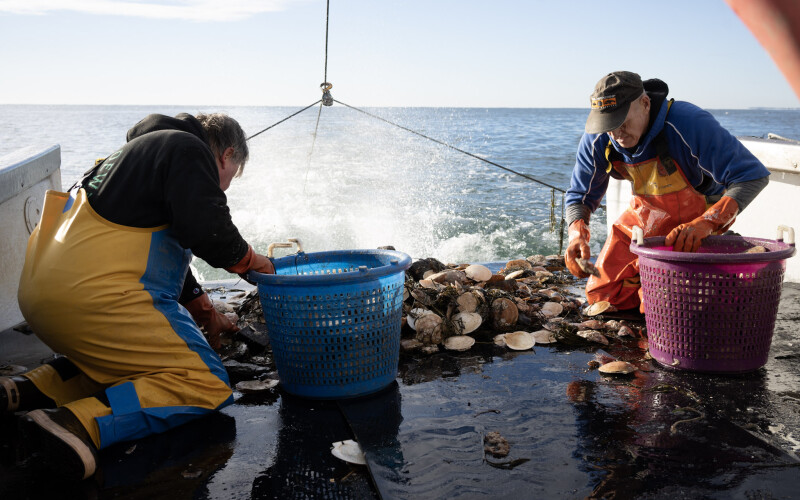There is a fantastic restored 1963 documentary film “The Pearl of the Atlantic” about the New Bedford, Mass. scallop industry. It shows a now-defunct scallop festival that started in the 1950s, along with the crowning of a Scallop Queen. The film has a dream-like quality.
The Maine scallop fishery
If anyone qualifies as a modern version of a scallop queen, it may be someone like Togue Brawn, the owner of Downeast Dayboat, a Maine-based direct-to-consumer business that hooks people up with Maine dayboat scallops, all within 24 hours.
Brawn has been in the industry for three decades. Her message is that Maine dayboat scallops, which represent about 2 percent of all U.S. sea scallops, are unlike those from the offshore federal waters fishery. Brawn says consumers know this “by how they taste.
Recently, Brawn was in New York City with the Académie Culinaire de France, where she put Maine sea scallops in the spotlight for professional chefs from France, Canada and the U.S. Next, Brawn will travel to France, to learn about preparing scallops with “roe on” – something not yet done in Maine.
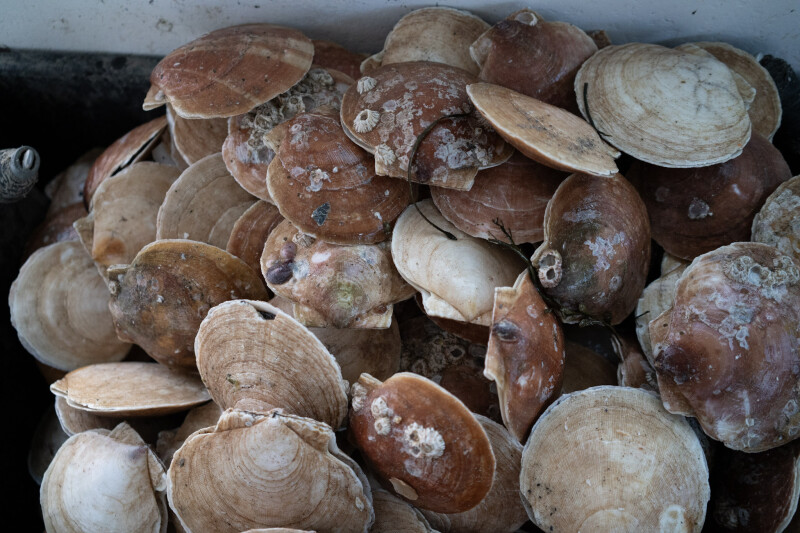
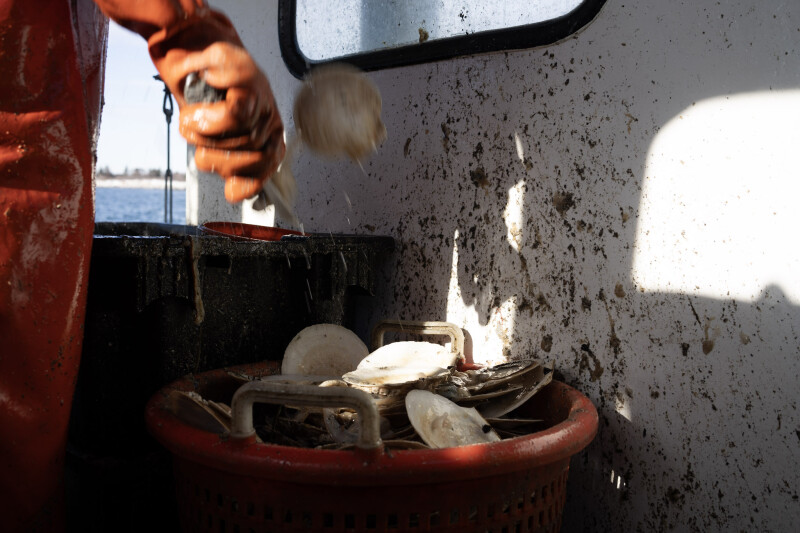
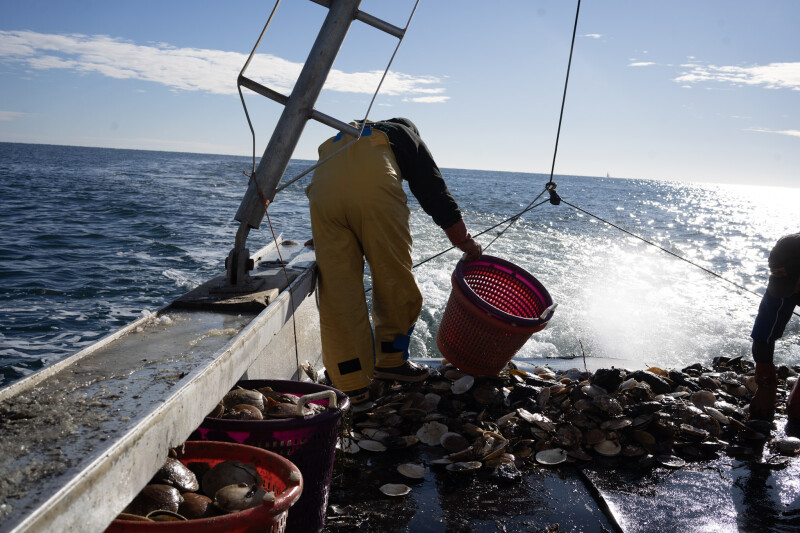
Maine’s state scallop fishery runs from December to March, and Brawn works with 8-10 guys who run dayboats. While her outfit and scale are small, and she buys about one thousand pounds per year, she pays premium prices to the fishermen.
“It’s been a soft year,” adds Brawn. Since most Maine scallops come from Downeast and they are on a rotational schedule, this has not been a strong year. “Plus,” adds Brawn, “Maine DMR (Department of Marine Resources) maybe left them open too long years ago – which left fewer to grow?”
The Federal Waters Fishery
For federal trip boat scallops, in late January 2023, 10-20 Closed Area II scallops at the New Bedford Auction were earning $13.90 per pound on average, while U-10 Channel Scallops got $16.30. “If you look at the daily auction board from New Bedford, you’ll see prices for U-10s are much lower than they were in recent years, which has pretty much been the case all fishing year,” says Jonathon Peros, fishery analyst, and scallop plan coordinator at the New England Fishery Management Council.
Kirk Larson of Viking Village, a large dock and seafood production company in Barnegat Light, N.J., remembers when “U-10s were up in the $25-30 range in 2021.” But, he says prices dropped last year “and never really came back up.”
As for why U-10 prices have been low this year, Larson has some ideas.
“It’s because we priced ourselves out of the market. We’re not catching a lot. I think the major reason the price is down, and demand isn’t up is interest. Freezer costs don’t help.” He also speculates that some larger contracts companies held with cruise boats were dropped when scallop prices got too high.
For Alex Todd, the federal fishery is always a wildcard. For him, the federal fishery went well last spring before it got cut short.
“The catch and prices were good, but with the reactivity of more boats this season, [it] keeps shrinking. For the federal fishery in the Northern Gulf of Maine zone (NGOM), the daily limit is 200 pounds. Depending on the TAC (total allowable catch) and how many boats are active, I think we’ve had as low as 15 trips. Two years ago, I think it was something like 48 trips.”
Jonathon Peros of NEFMC says “permit data suggests that folks are looking to enter into the NGOM portion of the federal fishery, and participation in the NGOM has increased to over 100 vessels taking trips the last two years.” But, Peros adds, that there is accessibility of the scallop resource to fleets right now: “There are dense beds of large scallops that are short steam out of Gloucester.”
Lars Vinjerud, CEO and owner of Fleet Fisheries, in New Bedford, Mass., says “for U-10s, we haven’t had a problem with prices. The problem is we can’t fish. We’re fishing about 32 days.” Vinjerud says about 40 of his boats were tied to shore last year, for a year, “and I took the insurance off them.” He says another challenge is the value of his boats and permits have dropped by over 20 percent in recent months.
In 2022, total commercial landings totaled 31.6 million pounds of meat, valued at $478 million, according to NOAA Fisheries data. This was a significant decrease over 2021 landings of 43 million pounds valued at $670 million. And in 2023, there was a dip too. “Last year the Council recommended a scallop harvest of roughly 25 million pounds,” says NEFMC’s Jonathan Peros, “with an estimated revenue of just under $400 million dollars.”
These are drops from 2018 to 2020, when landings exceeded 50 million pounds, according to data.
Vinjerud remains hopeful that “we can get more trips and days, and the government sees there are more scallops.” He would also like to see Northern Edge re-opened. Northern Edge of Georges Bank has been closed to mobile bottom-tending fishing gear since 1994 but has been discussed by regulators recently.
Peros adds that there are other things regulators are keeping their eyes on, including environmental change in the Mid-Atlantic and multi-year surveys indicating “a sharp decline in scallops at the southern extent of the range–particularly in areas east of Virginia and Maryland. Those areas once produced millions of pounds of harvest per year, now we don’t see many adult scallops there, and virtually no fishing activity.” Due to the data in the Mid-Atlantic, the Council voted to reduce Limited Access Days-at-Sea to 20 – the lowest ever allocated adds Peros.
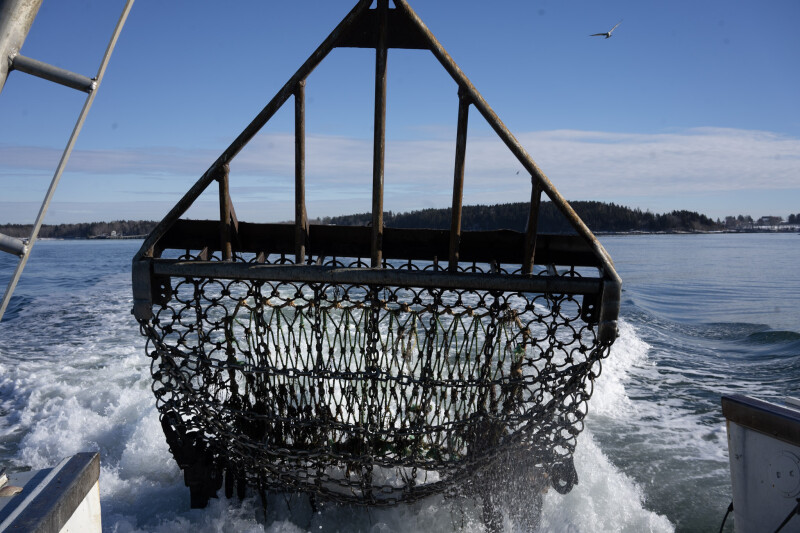
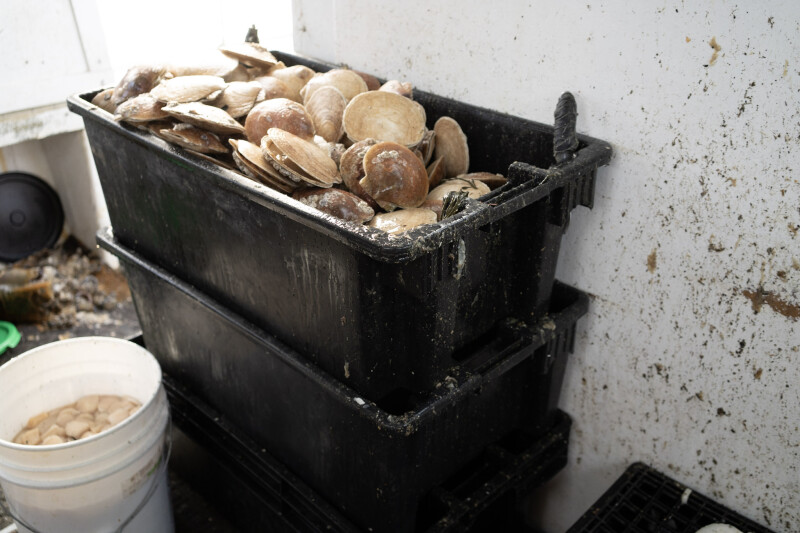
The NEFMC’s Scientific and Statistical Committee (SSC) recommended scallop fishery ABCs of 47.4 million pounds (21,497 metric tons) for 2024 and 49.8 million lb (22,586 mt) for the 2025 fishing year, after accounting for discards and incidental mortality. The SSC will reevaluate and potentially adjust the ABC for 2025 when the Council develops the next framework adjustment.
According to Jonathon Peros, things shake out like this: “For full-time limited access vessels, the allocations between 2023 and 2024 could be similar in terms of pounds landed. In 2023, the Council allocated two 12,000 pound access area trips and 24 DAS [days at sea.]. For 2024, those vessels will have three 12,000 pound trips, and 20 DAS.”
Scallop imports
A twist for markets emerged in August 2023, when China placed a ban on Japanese imports, following the release of wastewater from the damaged Fukushima Daiichi nuclear power plant.
Lars Vinjerud of Fleet Fisheries says this impacted markets because large volumes of scallops from Japan, normally bought by China, were instead brought into the U.S. “U10, U10/20s. The quality was so-so. But the price was low, and it hurt our price last spring.” But, he says, things are stabilizing.
Vinjerud says the key thing for consumers is: “The domestic scallop is still way superior to imports. You may have to pay a little more, but you’re getting a better product and protein and supporting American fisheries.”
Kirk Larson adds, “Chefs are under the gun to put out a platter that middle class Americans can afford. But I’d rather eat something from our country.”
Ocean acidification and other challenges
“We’ve been through good times and bad times, now windmills (offshore wind energy projects) are a threat.” Larson points to recent studies about negative impacts of sound on scallop beds.
Meanwhile, the changing climate is something the entire industry faces. A February 2023 study revealed that ocean acidification and ocean warming might adversely impact sea scallop productivity in the Atlantic and Gulf of Maine, in coming years. The study was published by federal scientists and Massachusetts Maritime Academy in collaboration with NOAA.
“The Council is acutely aware of how a changing environment is impacting fish and fisheries,” adds Jonathan Peros from NEFMC. “Regulators account for changes in growth in stock assessments and in the Council’s annual catch setting process.”
Upshot
Some positive developments, says Peros, are that scallops in a closed area east of Cape Cod should be ready for harvest in 2024 through rotational fishing. “Surveys also saw billions of 1-year old scallops in the Nantucket Lightship Region… if they make it to 2-years old, it will be a good sign.” Over on eastern Georges Bank, Area II continues to support rotational fishing. 2024 marks the fifth consecutive year access area fishing has occurred in the region, which is the longest stretch of openings since the start of rotational management.
Aquaculture is also something to keep an eye on. Togue Brawn says the texture of scallops grown via aquaculture is different from wild caught, which is something consumers will adjust to. “They close shells more regularly, so they build muscle – kind of like a buff scallop!”
Additionally, Brawn is embracing a new approach in her marketing. “I’m starting to gain traction with this whole concept of merrior in seafood, which is like terroir in wine.” It is based on the idea that wine and scallops taste different, depending on what area they are from and the unique environmental factors shaping the character. The initiative is Merrior.Me and might draw in new consumers familiar with the concept from the wine world.
Brawn is keenly aware there is room and demand for both trip boat scallops, and day boat scallops in the market. She has witnessed consumer education and interest in scallops evolve over her time in the industry, which she sees as positive for everyone. “No question, when I first started so many were mis-labeled ‘diver scallops’ now I see ‘dayboat’ on menus, which makes me happy.”





